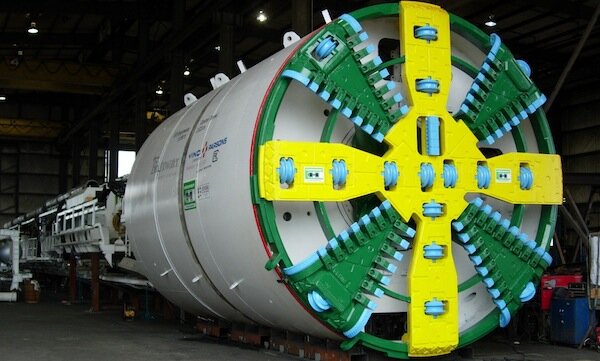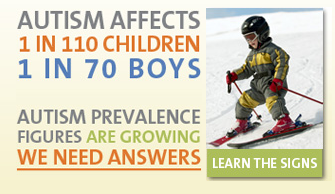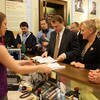 The damaged BT-3 boring machine in shinier days. Photo: King County.
The damaged BT-3 boring machine in shinier days. Photo: King County.
I was a little surprised to hear that the final phase of Brightwater tunneling is set for this fall. Back in mid-February, King County Executive Dow Constantine declared the project's status an "emergency," and I assumed that meant round-the-clock tunneling action. But really the emergency declaration was simply to allow Constantine to switch contractors, to Jay Dee Coluccio (JDC), and renegotiate terms with them. (JDC is also working on the University Link light rail project.)
After the tunneling that finished this June, the boring machines have been on hiatus while "reconditioning" is done. A fact sheet (pdf) explains:
JDC will move the tunneling machine that has mined from Point Wells into the 200-foot deep shaft at the Ballinger site. This will take about two weeks. Once the TBM is in the shaft, several sections will be lifted to the surface to be reconditioned. Remaining portions will be refurbished inside the shaft. Cranes will be used to lift the TBM sections to the surface and to lift equipment and crews in and out of the shaft.
Brightwater is a huge wastewater treatment system north of Seattle, with a 114-acre treatment plant, 13 miles of pipeline, and a marine outfall that, via twin pipes that shoot about a mile out into Puget Sound, diffuses treated water with the Sound. It's designed to treat 36 million gallons per day, and expansion planned by 2040 should increase that capacity to 54 million gallons....
 From the Autism Speaks website
From the Autism Speaks website
Sallie Tisdale has an article in Harper's (subscribers only) this month about her autistic daughter. There's an element of forestalled explanation to it; yes, she said "daughter."
My daughter, Annie, still lives with us. She is twenty-six now and at the moment is sitting on the porch, looking out at the street. Soon she will come in and pace for a while, her head down. Later she will read the first few pages of a book—the same book, the same pages, that she read last week and the week before, and will read again tomorrow.
"Autistic son" delivers 175,000 results on Google. "Autistic daughter," just 31,000. People are not sure why more boys than girls are found to have autism. Epidemiologically, the ratio is supposed to be about 3.6 boys to one girl.
It's known that girls can learn to mask some of the effects of autism more easily than boys, so it's possible that they are under-diagnosed in general. Studies show that hallmarks like "language deficits, tantrums, and aggression are all less common in girls than boys in the general population." A British researcher raises the specter of a shadow population of "shy" girls who like to keep lists and count calories (even to anorexia).
Tisdale's story is a primer on autism's variability, and its effects on everyone who struggles with it, including caregivers. Tisdale recounts the lifelong challenge of it: the official optimism with which her daughter was handed off as she finished school, the time her daughter started hallucinating and had to be given antipsychotic medication. Writes Tisdale:
Long-term studies of people with autism are not reassuring. Autistic adults generally read poorly, have few math skills. Very few go to college, are employed, or lead independent lives. The majority say they have no friends....
(more)
Autism is a major research driver in the Northwest--in Seattle we have both the UW's Autism Center and Seattle Children's Autism Center (along with an autism walk and the Lakeside Center for Autism). Seattle Children's Autism Center is a recent creation, resulting from Children's friendly takeover of ASTAR, and offers both clinical study and treatment, making it a one-stop autism shop for families.
Tonight at 8 p.m., KING 5 is airing a Children's Healthlink Special, "The World Within: Northwest Stories of Autism" (also on KONG at 7 p.m. on January 3). Local icon Jean Enersen will be exploring the startling spike in autism rates--it's estimated that one in a hundred children have autism spectrum disorder (ASD)--and why researchers still don't know precisely what is responsible for either ASD or its increase.
What we do know is that when the CDC compared rates of diagnosis in eight-year-olds in 2006 and compared that to 2002, autism's prevalence had increased 57 percent. We also know that early intervention treatment has good results, but that the "early" part is absolutely key. Parents tend to notice something unusual about their children at age two, but in most cases official diagnosis and treatment don't occur until the child is over four years old.
In the House health care bill, $17 would be set aside during the first year for a "National Training Initiative on Autism Spectrum Disorders." This is after NIMH allocated $60 million in "stimulus" funding to promote research on better, earlier means of diagnosis and/or effective treatment for older children and adults with ASD. So autism is literally in all the headlines, though for the short term it seems we're more focused on learning how to live with it than on solid leads for cure or prevention.



Most Recent Comments